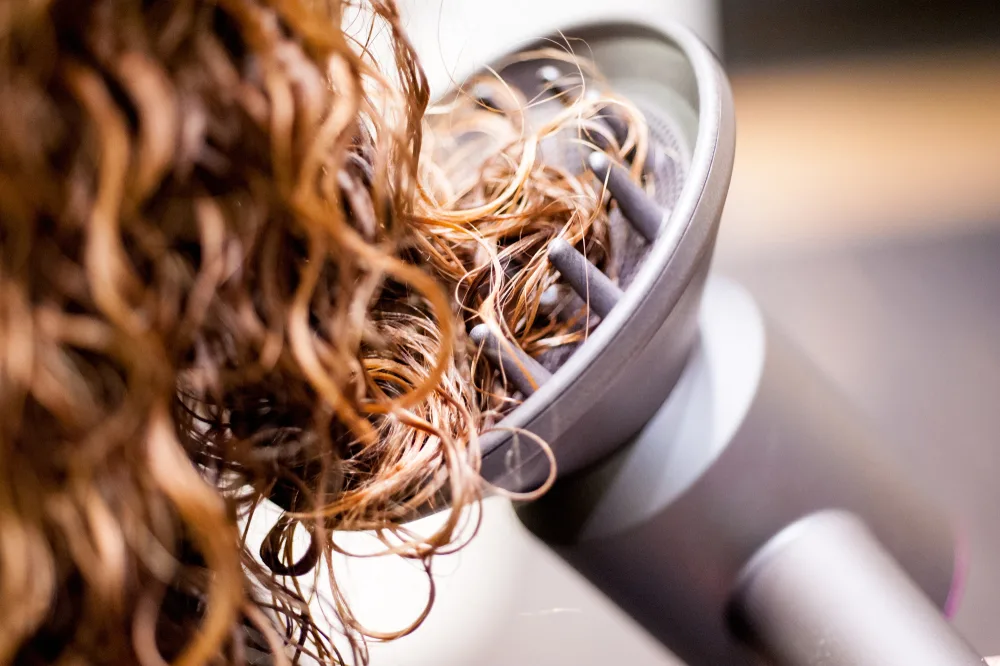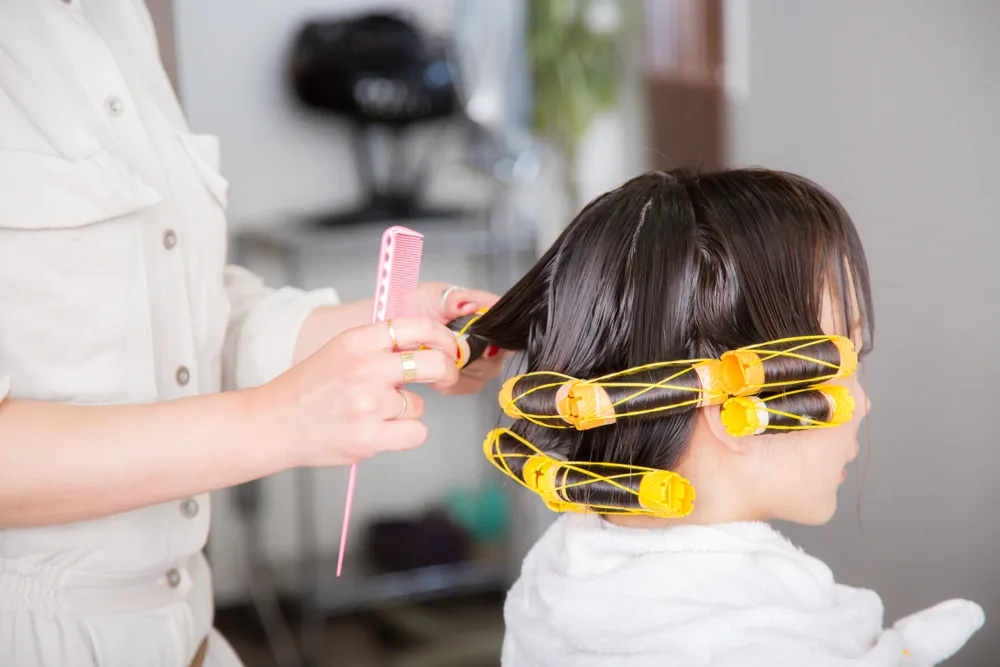Jump to:
A perm may alter your hair’s natural texture, yet, it offers you many new possibilities in your daily hair care and style. You should be wary of the potential for harm to your hair, as is the case with any chemical hair treatment.
If you ever wonder, “Are perms bad for your hair?” this is the article for you. Read on to learn the answer to this question and how to avoid damaging your hair too much by perming it.
What Is a Perm?
Perms use chemicals to alter the hair’s molecular structure to achieve the desired waves or curls. But, let’s be honest. Perms are terrible for you and your hair. Doing this is the worst thing for your hair and will cause irreparable damage over time.
A perm is a shortened term for a permanent hairstyle. The name pretty much says it all. A person with straight hair who desires curly hair might undergo an extensive chemical treatment to get their desired result.
Perms have been around since 1905. It was found when German hairstylist Karl Nessler developed the spiral heat technique. They added caustic sodium hydroxide soda to the client’s hair before curling around metal rods in his electric permanent wave machine.
Nowadays, hairstylists use various devices, chemicals, and methods to produce modern, trendy perms. Anthony Cole, a celebrity hairdresser, is famous for his innovative use of fabric and rollers to achieve a wide range of curls, waves, and other hairstyles.
You Might Also Like:
- When Can I Wash My Hair After a Perm?
- Types of Perms for Thin Hair
- How Long Does Your Hair Have to Be to Perm?
- Can You Perm Bleached Hair?
- The 9 Most Common Types of Perms
How Perming Works
The hair’s disulfide bonds dissolve by reducing chemicals like bisulfites and thioglycolates. These reducing chemicals penetrate deep into the cortex, below the disulfide bonds, where they may do their work.
The alkaline agents raise the cuticle scales for the reducing agents to penetrate the cortex. Curlers and rods arrange the hair fibers in the intended wave or curl pattern.
When the desired style takes hold, an oxidizing substance such as hydrogen peroxide reverses the process in the hair fibers. To get a perm, hairstylists wrap the hair around rods. After that, they apply the curling or wave-setting perming solution.
After the hair curls, the perming solution washes out, and they stop the process using a neutralizer. You may achieve curls and waves using a variety of formulae and procedures, each employing a unique item.
Are Perms Bad for Your Hair?
A perm significantly weakens the hair, and the effects of other damaging components, such as color and heat, which amplify. Split ends result from hair follicles becoming weaker.
The volume of your hair diminishes after getting a perm. Long-term perming results in hair thinning and eventual loss. Because of the moisture loss, permed hair tends to feel quite dry. It facilitates the unraveling of your hair.
In addition to these consequences, it also prevents hair from growing. The process may cause damage to hair if applied incorrectly.
There is minimal room for mistakes when adding chemicals to your fragile strands. Hair perming has several risks, including dry hair, chemical burns, and hair breakage. Look at how perms affect different hair types to see how they can damage your hair.
Virgin Hair
The process of perming virgin hair is comparable to that of painting on a blank canvas. Because you don’t have to work on top of an already existing image, you can get the most satisfactory possible outcomes. Compared to other kinds of hair, perming virgin hair causes the least damage.
Highlighted Hair
If up to forty percent of your hair is highlighted, you should anticipate that the perming process will cause some degree of damage to it.
If you previously bleached your hair, applying more chemicals to it will further damage the cuticles of your hair, causing it to become dry and frizzy.
Dry Hair
People with dry hair could find keeping a perm in place challenging. Before you put your hair through a comprehensive perming procedure, you may want to recondition it and moisturize it if it’s already in a fragile state due to dryness and lack of moisture.
Because perms essentially take over your hair strands and transform them from the inside out, the new hair you get from getting a perm has a significant risk of damage.
Hair damage may occur during perms when the hair and scalp’s appropriate pH levels suffer alteration. The pH level is naturally from 4.5 to 5.5. The pH of chemical perms is roughly 9.5, which is unusually high.
The greater the pH level, the more harmful its effects on the hair. They may cause a pH imbalance if they touch the hair and scalp due to their high pH. The scalp might become greasy, itchy, dry, and irritated if the hair’s pH balance changes.
Read Next: How to Moisturize Permed Hair
How to Maintain and Care for Your Perm

Graciellademonne/Shutterstock
Maintaining your new style is essential if you want to prevent frizz and knots, as with any curls. Here’s everything you need to know to care for your perm and to avoid dryness and frizz.
Hydrate
If you’re going to perm your hair, give it the best chance of survival by taking the utmost care. A perm is a damaging process since it dries out your hair.
The perming procedure may make your curls seem even more lifeless and unhealthy if your hair is already damaged. Once a week, treat your permed hair with hydrating and nourishing hair treatment.
Avoid Washing too Soon
The greatest no-no in taking care of permed hair is washing it too soon after the treatment. We suggest listening to your stylist at all times. You should wait 48 hours after getting a perm before you wash it.
Treat Permed Hair as Curly Hair
You should take care of your perm, in the same manner, you would need for your hair if it were naturally wavy by utilizing products and styling processes intended exclusively for curls.
Condition and Moisturize
Your hair will suffer some damage from the perming process, as it would from any chemical treatment. Always follow up a shampoo with a conditioner for optimal results. A deep conditioning treatment will tame unruly hair by infusing the strands with moisture.
Stay Away From Heat
Damage and frizz are just a few potential side effects of blow-drying and straightening your hair. Don’t risk ruining your beautiful curls by not using enough heat protectants. Wait until your hair is nearly dry before using a blow dryer so that you can maintain the curl without creating frizz.
Use the Appropriate Hair Products
Because it involves chemicals, perming the hair may dry out or damage the strands. Solutions feeding your locks from the roots to the ends can help you battle this.
Use hair care products that include ingredients that repair the look of permed hair when you wash your hair.
Create a Consistent Night Regimen
It might be difficult for someone new to permed hair care to get used to sleeping with curls. We suggest sleeping with your hair wrapped in a silk cloth or pillowcase to prevent waking up to frizzy or twisted locks.
Using this technique, you may reduce the appearance of texture and frizz, reducing the friction on the hair’s cuticle.
Should You Get a Perm?
A perm is an excellent method to experiment with your hair’s texture and see how it appears in a new style. And you may appreciate a perm if you’re bored with the existing texture of your hair.
You may transform your appearance by adding a dramatic flare to even the most boring styles if you have naturally dull hair. However, a perm isn’t for everyone. You shouldn’t get a perm if you constantly experiment with different hair textures.
Frequently Asked Questions

buritora/Shutterstock
Here are some of the most frequently asked questions regarding permed hair:
Is it harmful to perm your hair?
When done correctly, perms are no worse than other hairstyle methods, such as blow-drying. Compared to bleaching, perming is safer to perform. However, perming hair poses a certain degree of danger to the hair’s health.
Is it challenging to maintain a perm?
Permed hair needs regular upkeep to keep it looking good and manageable. A new perm needs anywhere from three to six months after the first one.
How frequently should you wash your perm?
After perming your hair, don’t wash it for at least 48 hours. Otherwise, your hair may lose its wavy curls and revert to its original structure. You should clean your hair once a week after the perm takes effect. If your hair becomes oily, apply a dry shampoo to add structure and volume.
How to undo a perm for curly hair?
If you’ve used a hair relaxer on your curls and aren’t happy with the results, you may let your hair grow out naturally, try some low- or no-manipulation styles, or cut your hair. Either way, you should consult an expert you know you can rely on.
How long does a perm last?
Usually, perms can last up to six months.
So, Are Perms Bad For Your Hair?
As we have stated thoroughly, a perm harms your hair in many different ways. Follicles lose their natural shape causing breakage and split ends.
However, following our advice can minimize the damage, protect your hair from harm and keep it healthy. We hope that we address your worries concerning hair damage due to perm. Happy styiling!
